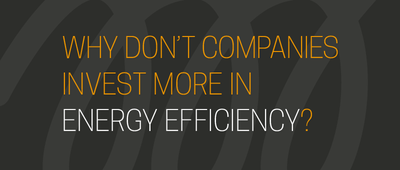Columnists: Steven Fawkes, EnergyPro

Published on: 27 Nov 2018
Time to change our game: cost saving is not enough
The latest Energy Efficiency market outlook report from the International Energy Agency (IEA) strikes a familiar note. It shows that “the right efficiency policies could alone enable the world to achieve more than 40% of the emissions cuts needed to reach its climate goals without requiring new technology”. And of those of us working in the industry are also well aware, “investment is not currently on track to achieve this goal”.
Global energy efficiency investment grew only marginally in 2017 (up by 3% to $236 billion), according to the IEA. About 60% of total efficiency investment is in the buildings sector, and I wholeheartedly endorse the IEA’s conclusion: this sector is ripe for “finance and business model innovation”. We need to change the game and make energy efficiency into something that people want to buy, and something that can be easily financed by institutional capital at scale.
The foundations of a real energy efficiency financing market are now being put in place. Rather than grants and subsidies as the currently dominant policy instrument, the IEA report highlights white certificate and energy efficiency obligation schemes as examples of the kind of market-based instruments (MBIs) that can drive the investment needed. Good news: the amount of investment here has increased six-fold over the last ten years, with the majority of MBIs achieving public/private leverage rates of up to 200%, meaning that for every dollar of public investment, two dollars of private sector investment is triggered.
But to really scale up, we need to put together the four pieces of the jigsaw of energy efficiency investment. The four pieces are; finance (for projects and development), standardisation, large-scale pipelines, and capacity building on the demand side, the supply side and within the financial sector.
Project finance is abundantly available and much of it is seeking environmentally conscious or green homes – the issue right now is a lack of projects. Many failed energy efficiency finance schemes show that providing project finance alone is not enough.
Finance for project development bridges that risky stage between “here is a good project idea” and “here is a fully developed bankable project”. Public capital is probably best used to kick-start the development market using low cost convertible loans or grants such as the EU’s Project Development Assistance.
Standardisation in the development and documentation of projects is now available through the Investor Confidence Project. The Investor Ready Energy EfficiencyTM project certification system is available in the US, Canada and across Europe. For energy efficiency investment in buildings, the ICP system reduces due diligence costs and increases certainty of outcome – invaluable for project developers, clients and financiers.
To develop large-scale pipelines that can attract institutional capital requires several things. Firstly, it needs entrepreneurial efforts to acquire and build pipelines. Secondly, it needs business models that really make sense for clients. Existing models such as Energy Performance Contracts do not make sense for large parts of the market. Emerging models such as Efficiency Services Agreements, metered efficiency and Pay for Performance are more attractive and need to be developed and deployed. Strong leadership from client organisations and portfolio holders such as central, city and local governments is needed to drive effective action at scale.
And capacity building amongst clients – the demand side – needs to focus on the benefits of improved energy efficiency and the availability of financed solutions. More people need to know what to ask for, especially the more strategic and more attractive non-energy benefits.
Stressing mere energy cost savings is not enough: non-energy benefits such as increased asset value, more productive workers, or better product quality are likely to prove much more valuable and more strategic, than the savings on energy consumption. The key thing here is to continue to talk about the existence of non-energy benefits and get project developers and valuers/investors to include them in the economic assessment.
On the supply side capacity building needs to focus on developing standardised and bankable projects with consistent results. This will seriously boost the X-factor identified in the IEA report: “one factor favouring greater levels of investment is the replicable and scalable nature of building energy efficiency projects that have predictable returns and can be aggregated to appeal to third-party financiers.”
Help is at hand, for example via the EEFIG Underwriting Toolkit, designed to assist financial institutions to scale up their deployment of capital into energy efficiency, the DEEP database, evidencing returns on energy efficiency investment, and the Sustainable Energy Investment Forums convening public authorities, financial institutions and project promoters across Europe.
We need to understand and assemble all the pieces of the jigsaw simultaneously. New technology will not accelerate energy efficiency investment and get to 40% of the emissions cuts needed to beat climate change. But the right policies, business models, finance, and values might.







